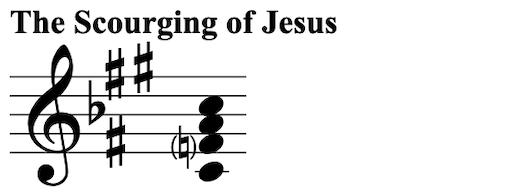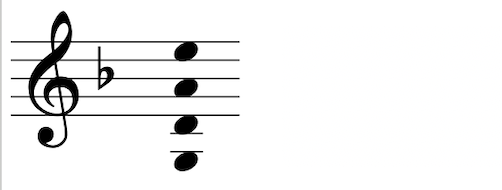The Mystery Sonatas
The Joyful Mysteries
Sonata I in D minor: The Annunciation
Praeludium - Aria and 2 variations - Finale
Sonata II in A Major: The Visitation
[Sonata] / Presto - Allamanda - Presto
Sonata III in B minor: The Nativity
[Sonata] /Presto - Courente and double - Adagio
Sonata IV in D minor: The Presentation of Jesus in the Temple
Ciacona with 12 variations
Sonata V in A Major: The Finding of Jesus in the Temple
Praeludium - Allamanda - Gigue - Sarabande and double
The Sorrowful Mysteries
Sonata VI in C minor: The Agony in the Garden
Lamento
Sonata VII in F Major: The Scourging of Jesus
Allamanda and variation - Sarabanda and 3 variations
Sonata VIII in Bb Major: The Crowning of Jesus with Thorns
Sonata: Adagio/Presto - Gigue and 2 doubles
Sonata IX in A minor: The Carrying of the Cross
Sonata - Corrente and 2 doubles - Finale
Sonata X in G minor: The Crucifixion
Praeludium - Aria and 5 variations
The Glorious Mysteries
Sonata XI in G Major: The Resurrection
Sonata - Hymn: Surrexit Christus hodie and variations
Sonata XII in C Major: The Ascension
Intrada - Aria tubicinum (trumpet) - Allemanda - Courante and double
Sonata XIII in D minor: The Descent of the Holy Ghost
Sonata - Gavotte - Gigue - Sarabanda
Sonata XIV in D Major: The Assumption of the Virgin
[Sonata] - Arias 1 and 2 - Gigue
Sonata XV in C Major: The Coronation of the Virgin Mary
Sonata - Aria with 3 doubles - Canzona - Sarabanda and double
Passacaglia in G minor for violin alone
Program Notes by Martin Pearlman
Heinrich Biber's Mystery (or Rosary) Sonatas rank, along with Bach's unaccompanied violin music, among the most challenging works in the Baroque violin repertoire, and his experimentation with the instrument is unique, even to this day. Heard as a collection, they are astonishingly powerful and deeply emotional.
One of the greatest violinists of the seventeenth century, Biber wrote not only avant-garde music for his own instrument but also many large and small-scale choral works, which only recently have begun to receive the attention they deserve. His choral output includes masses, requiems, motets and other works, some of them among the grandest church music of his time. (One polychoral mass attributed to him is scored for 53 voice parts!)
Heinrich Biber was born in Bohemia in 1644 and worked earlier in his career at the courts of Graz and Kroměříž (now in the Czech Republic), but from the 1670's until the end of his life, he was employed at the archbishop's court in Salzburg. There he rose to the rank of Kapellmeister and was eventually granted a title of nobility by the emperor.
The Mystery Sonatas survive in only a single manuscript copy dating from the 1670's. It is a beautifully copied volume comprising fifteen sonatas plus a concluding passacaglia for unaccompanied violin. Each of the fifteen sonatas depicts one of the mysteries of the rosary and is paired in the manuscript with an anonymous engraving illustrating the appropriate episode in the life of Jesus or Mary. The concluding Passacaglia, generally considered the greatest unaccompanied violin piece before Bach, shows an engraving of a guardian angel leading a child.
As with the spoken prayers of the rosary, the fifteen sonatas are grouped into three sets of five -- five joyful mysteries, five sorrowful mysteries, and five glorious mysteries. The occasion for which these pieces were written is itself something of a mystery, although they may have been played during the month of October, which was dedicated to the celebration of the rosary. Devotion to the rosary was particularly widespread in Europe at this time, and Salzburg had a Confraternity of the Rosary, of which Biber's employer, the Archbishop Maximilian Gandolph, was a member. Addressing the archbishop, Biber dedicated his collection "to the fifteen sacred mysteries, which you promote so fervently."
The sonatas do not tell the story of the lives of Jesus and Mary in any obvious way. Although there is occasional tone painting depicting dramatic moments, such as the fluttering of the angels' wings, the hammering of the nails, or the earthquake, some listeners have wondered and some writers have speculated about exactly how the sonatas relate to their mysteries. Why, for example, is there sometimes a dance or virtuosic passage in the middle of a sorrowful part of the story? Were some of these sonatas adapted from pieces written earlier for other occasions? Rather than explicit storytelling, the music seems to provide us with moments of reflection, leaving each listener to find his or her own meaning.
Interestingly, the anguished "Crucifixion" Sonata (No. 10) was reworked several years later into a secular version with titles related to a current event, the siege of Vienna, rather than the crucifixion.
Biber's technical experiments
It is perhaps not surprising that a virtuoso player like Biber would write technically challenging music. However, these sonatas go far beyond normal virtuosic writing. Biber instructs the violinist to tune the strings differently from the way they are conventionally tuned, so that no two sonatas have the strings tuned to the same set of notes.
The effect of this "untuning" or scordatura is not only that the violinist can play chords that are normally impossible on the violin but, more importantly, that the instrument resonates differently for each sonata. Tuning strings higher creates greater tension on the instrument, and tuning some of them lower makes it less bright. When the strings are tuned to the notes of a particular key, that key sounds more resonant, since the open strings vibrate sympathetically with the notes in that key.
For the player, having a different tuning for each sonata can be disorienting at first, not only because the fingers need to press down in slightly different places on the strings, but also because many of the notes that she is reading and fingering are not the ones that are actually sounding. For example, notes that are written as large leaps may actually sound close together in some sonatas; and, as shown below, some tunings result in bizarre key signatures which include both sharps and flats. This means that the usual conventions for reading music shift for each sonata.
The most extreme altering of the strings occurs in Sonata XI (The Resurrection).In that one sonata, the middle two strings are crossed over each other both in the peg box and behind the bridge, so that one can literally see a cross on the violin. That places the thinner "A" string below the heavier "D" string, putting the strings out of order not only in their pitches but also in their feel. Violinists who spend years learning the feel of heavier strings in the lower range and gradually thinner ones as they go higher, have to adjust their instincts as they balance chords with the strings out of order.
Key signatures and tunings of the open strings
Sonata I
D minor
Normal violin tuning.
Sonata II
A Major
Lower strings raised a whole step. Creates open 5ths of A major.
Sonata III
B minor
Tuned in B minor chord. More tension on bottom 3 strings, which are raised a major 3rd. Top string lowered for less tension.
Sonata IV
D minor
Bottom string up a step; top string down a step. Creates open 5ths of D.
Sonata V
A Major
Open strings form A major chord. Top string tuned quite low.
Sonata VI
C minor
Most dissonant tuning of these sonatas. Creates a new, dark sound for beginning of the "sorrowful mysteries." Bottom strings raised; top strings lowered. All four tuned to notes in C minor scale.
Sonata VII
F Major
F major chord. Extreme tension on raised bottom strings. Top string lower (i. e. more slack) than in other sonatas.
Sonata VIII
Bb Major
Forms Bb chord. Greater tension on bottom string than in any other sonata: raised a 5th, so that violin cannot play below D. Top string lowered.
Sonata IX
A minor
Tuned to A minor chord. Bottom string raised a 4th, creating considerable tension in bass. Top two strings tuned normally.
Sonata X
G minor
Close to normal violin tuning. Only top string is lowered a step to darken the sound and put the open strings within the key of G minor.
Sonata XI
G Major
Middle two strings are crossed in peg box and behind bridge to represent a cross. D string sounds higher, A string lower. (See notes above.)
Sonata XII
C Major
Tuned in C major chord. Bottom string tuned very high, under tension. Top string quite low, less tension in sound.
Sonata XIII
D minor
Open strings form a bright A major chord.
Sonata XIV
D Major
All notes in D major scale. Bottom two strings raised a step, top string lowered a step.
Sonata XV
C Major
All notes are in C major scale. Top three strings lowered a step, creating less tension and somewhat richer sound.
Passacaglia
G minor
Return to normal violin tuning, not heard since the first sonata of the set.
Boston Baroque Performances
The Mystery Sonatas
June 14, 2019
Connecticut Early Music Festival, New London, CT
Soloist:
Christina Day Martinson, violins
Continuo:
Martin Pearlman, harpsichord and organ
Michael Unterman, cello
Michael Leopold, continuo
May 5, 2018
Rice University, Houston, TX
Soloist:
Christina Day Martinson, violins
Continuo:
Martin Pearlman, harpsichord and organ
Michael Unterman, cello
Michael Leopold, continuo
March 10, 2017
NEC’s Jordan Hall, Boston, MA
Soloist:
Christina Day Martinson, violins
Continuo:
Martin Pearlman, harpsichord and organ
Michael Unterman, cello
Michael Leopold, continuo
March 7, 2017
Bechtler Museum of Modern Art, Charlotte, NC
Soloist:
Christina Day Martinson, violins
Continuo:
Martin Pearlman, harpsichord and organ
Michael Unterman, cello
Michael Leopold, continuo
March 22, 2013
First Church in Cambridge, Cambridge, MA
Soloist:
Christina Day Martinson, violins
Continuo:
Martin Pearlman, harpsichord and organ
Sarah Freiberg, cello
Victor Coelho, theorbo
February 12, 2012
First Church in Cambridge, Cambridge, MA
Soloist:
Christina Day Martinson, violins
Continuo:
Martin Pearlman, harpsichord and organ
Sarah Freiberg, cello
Victor Coelho, theorbo
March 4 & 5, 2011
NEC’s Jordan Hall, Boston, MA
Martin Pearlman, harpsichord and organ
Soloist:
Christina Day Martinson, violins
Continuo:
Martin Pearlman, harpsichord and organ
Sarah Freiberg, cello
Victor Coelho, theorbo

















